Papers by Camila van Diest
Iberoamericana, 2024
El artículo explora las memorias de la Ex cárcel de Valparaíso desde el prisma de la mirada docum... more El artículo explora las memorias de la Ex cárcel de Valparaíso desde el prisma de la mirada documental desarrollada en dos filmes chilenos, "1985 Valparaíso Cárcel Pública" y "Arcana", centrados respectivamente en la prisión política y en el mundo carcelario de derecho común. Se discute cómo las dinámicas de circulación de los filmes participan en la elaboración de distintas memorias carcelarias. El trabajo propone así una lectura cruzada de procesos de construcción de memorias y de producción del valor simbólico de los filmes.
Disponible en :
https://hal.science/hal-04672535
https://doi.org/10.18441/ibam.24.2024.86.215-238
CUHSO, 2023
Durante los últimos años, las iniciativas de memorialización de las espacialidades del terrorismo... more Durante los últimos años, las iniciativas de memorialización de las espacialidades del terrorismo de Estado en Chile se han multiplicado, incluyendo distintas escalas y formatos. En este contexto, el artículo explora la construcción de una “ruta de la memoria” en la región de Valparaíso, a partir de la experiencia de los actores ciudadanos e institucionales que la llevan adelante. Para ello, se analizan las colaboraciones, prácticas y reivindicaciones que acompañan la materialización del proyecto en distintas localidades de la región.
Proceedings du Congrès du Collège international des sciences territoriales - CIST 2020 , 2020
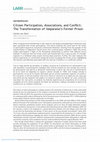
Latin American Research Review, 2020
After a long period of dictatorship in Latin America, the quality and deepening of democracy have... more After a long period of dictatorship in Latin America, the quality and deepening of democracy have been associated with citizen participation. This article examines the social uses of the notion of participation beyond an exclusively institutional dimension. Starting from the example of the transformation of Valparaíso’s former prison into a cultural space, initiated in 1999, this article studies participation in light of the fluctuating relationships to politics that different actors maintain. It examines how the former prison was transformed into a cause as part of a broader response to a neoliberal urban project and top-down practices. Further, this work analyzes the diverse experiences of commitment among the artists occupying the former prison, highlighting the tensions and dilemmas associated with the exercise of politics in a conflictual context.
Cahiers de géographie du Québec, vol 63, n°178, 2019
Having historically developed around its industrial port, the city of Valparaiso has been experie... more Having historically developed around its industrial port, the city of Valparaiso has been experiencing a crisis since the 1990s. Economic recovery policies were implemented in the 2000s, focusing on the sectors of heritage and tourism as well as the development of universities. The decommissioning of the former prison and its gradual transformation into a cultural park are concurrent with this process of urban transformation. This article explores the relationship between the prison and the city through the memories of Valparaiso's residents, suggesting that the ways in which people remember their proximity to the prison, associated with their experiences in the neighbourhood and its ongoing urban changes, brings to light the new social boundaries that are being produced.
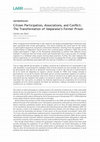
Latin American Research Review, 2020
After a long period of dictatorship in Latin America, the quality and deepening of democracy have... more After a long period of dictatorship in Latin America, the quality and deepening of democracy have been associated with citizen participation. This article examines the social uses of the notion of participation beyond an exclusively institutional dimension. Starting from the example of the transformation of Valparaíso's former prison into a cultural space, initiated in 1999, this article studies participation in light of the fluctuating relationships to politics that different actors maintain. It examines how the former prison was transformed into a cause as part of a broader response to a neoliberal urban project and top-down practices. Further, this work analyzes the diverse experiences of commitment among the artists occupying the former prison, highlighting the tensions and dilemmas associated with the exercise of politics in a conflictual context.
Cuadernillo TEUC n°12, 2008
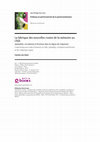
Cahiers du CAP, Éditions de la Sorbonne, 2019
Au Chili, la mémoire collective de la violence d’État exercée durant la dictature militaire (1973... more Au Chili, la mémoire collective de la violence d’État exercée durant la dictature militaire (1973-1990) apparaît aujourd’hui comme un héritage dissonant et controversé : la question de l’inscription spatiale de cette mémoire soulève tout particulièrement des résistances et catalyse des polémiques. Sur la base d’une enquête ethnographique menée en 2018, cet article porte sur la fabrique collective d’une « route de la mémoire » dans la région de Valparaiso. Il s’agit d’interroger le travail par lequel les lieux qui constituent les cadres spatiaux de la mémoire d’un passé violent sont pensés comme faisant partie d’un réseau, ainsi que les modalités de leur marquage physique et symbolique. Par-là, l’article propose de saisir les projets de mémorialisation à l’aune des enjeux de la justice spatiale et des ancrages territoriaux des groupes qui les mobilisent.

De la participation à la co-construction des patrimoines urbains. L'invention du commun?, 2017
Ce travail propose d’étudier la genèse du regard patrimonial de l’ancienne prison de Valparaiso –... more Ce travail propose d’étudier la genèse du regard patrimonial de l’ancienne prison de Valparaiso – connue comme Ex-cárcel —, transformée progressivement en espace culturel. Il s’agira d’identifier les acteurs et logiques qui œuvrent au « transfert » de la prison du monde carcéral à la sphère du patrimoine, en produisant une valeur qui contraste avec sa connotation négative précédente, et qui à cet égard s’avère "dissonante". Loin de constituer un champ de coopération consensuel, cette construction entraîne des tensions entre positions différentes concernant les usages de l’espace. La co-construction patrimoniale dont l’Ex-cárcel est l’objet rejoint directement les débats sur la participation citoyenne locale ainsi que sur le travail artistique dans un contexte de précarité matérielle qui est celui de Valparaiso.
Disponible en ligne: https://halshs.archives-ouvertes.fr/halshs-01724626
En ligne : https://shs.hal.science/halshs-01546498
dans Arts, culture, mémoire, Péquignot, B... more En ligne : https://shs.hal.science/halshs-01546498
dans Arts, culture, mémoire, Péquignot, Bruno et Cécile Prévost-Thomas (dir.), Paris, L’Harmattan, coll. Logiques sociales, 2017, pp 89-108.
revista La Fuga: www.lafuga.cl, 2007
Les mondes de la médiation culturelle. Volume 1. Approches de la médiation. Camart, Cécile ; François Mairesse, Cécile Prévost-Thomas et Pauline Vessely (dirs.), Paris, L’Harmattan, coll. Les cahiers de la médiation culturelle, 2016. pp. 239-252. , 2016
Disponible en ligne: https://halshs.archives-ouvertes.fr/hal-01473483
Organización y poéticas de la compañía Teatro de Chile 1
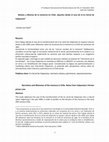
Cabo dos trabalhos, n.10, 2014
Este trabajo aborda el caso de la transformación de la ex cárcel de Valparaíso en espacio cultur... more Este trabajo aborda el caso de la transformación de la ex cárcel de Valparaíso en espacio cultural, desde el año 2000, para reflexionar sobre las tensiones de la memoria en el Chile de comienzos de siglo. Asumiendo la territorialidad como uno de los " marcos sociales de la memoria " (Halbwachs), considero en primer lugar la inscripción memorial de la cárcel, particularmente en lo relativo a su dimensión urbana-barrial, explorando los alcances que esto plantea respecto a un imaginario político asociado al espacio. En segundo lugar, interrogo en qué medida los discursos relativos al estatuto de " Patrimonio de la humanidad "-con el que Valparaíso es investida en 2003 por la UNESCO-se conectan a los debates en torno a la rehabilitación del antiguo penal. Considerando las lógicas de patrimonialización y marketing urbano que intervienen Valparaíso, se pretende abrir perspectivas críticas sobre las articulaciones entre memoria y patrimonio en el Chile actual.
Revista austral de ciencias sociales, 2014
Lizama Flores, Carla y Felipe Montalva Peroni (comp.), De boca en boca. Historias y reflexiones en torno al Encuentro de Teatro Porteño Independiente ETPI (2004-2012). Valparaíso, 2012. pp. 45-53.
En: Lizama Flores, Carla y Felipe Montalva Peroni (comp.), De boca en boca. Historias y reflexion... more En: Lizama Flores, Carla y Felipe Montalva Peroni (comp.), De boca en boca. Historias y reflexiones en torno al Encuentro de Teatro Porteño Independiente ETPI (2004-2012). Valparaíso, 2012. pp. 45-53. El año 2004, la compañía Teatro La Peste, formada por actores egresados de la Escuela La Matriz, de Valparaíso, crea el Encuentro de Teatro Porteño Independiente (ETPI) 1 . Cumpliendo hoy nueve versiones, el evento se presentaba como respuesta a los entonces vigentes Carnavales culturales, evento oficial que tendría lugar cada fin de año entre 2001 y 2010
Telondefondo. Revista de teoría y crítica teatral. N°10, diciembre 2009. ISSN: 1669-6301. http://www.telondefondo.org/
On year 2004, the theater company Teatro la Peste, creates the Encuentro de Teatro Porteño Inde... more On year 2004, the theater company Teatro la Peste, creates the Encuentro de Teatro Porteño Independiente , as a direct alternative to the Valparaiso's Carnavales Culturales
, which years earlier had been promoted by the chilean government. The meeting, which is realized until today, looked forward to create a platform for the multiplicity of people related to the theater in the region and to democratize the access of the public, facing up the institutional discourse on culture in a city marked by it's status of "cultural capital of Chile". This article proposes different reading keys in order to get an insight of the tensions between both events
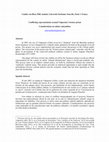
In 2007, the city of Valparaiso (Chile) received a "donation" from the Brazilian architect Oscar ... more In 2007, the city of Valparaiso (Chile) received a "donation" from the Brazilian architect Oscar Niemeyer. It was a blueprint for a cultural centre, planned to be built on the grounds of an old prison. This project was never implemented and caused serious discussions in the Chilean public sphere. The conversion of this prison into the "Former prison cultural park" coincides with the last phase of government of the centre-left political coalition created to defeat Augusto Pinochet's dictatorship (1973)(1974)(1975)(1976)(1977)(1978)(1979)(1980)(1981)(1982)(1983)(1984)(1985)(1986)(1987)(1988)(1989). This paper will focus on how the conflict set off by the Niemeyer project reveals an official representation for the country in which "cultural infrastructure" plays a crucial and symbolic role. This process starts as an implicit cultural policy, set forth by institutions without any relation to "explicitly" cultural issues. This project provides an analytical opportunity to gain insight into the articulations between cultural policies and the economic model that has been operating in Chile since the dictatorship.
Books by Camila van Diest
La inves tigac ión qu e dio o rigen a este libr o fue fina ncia da por el Fondo del Fom ent o Aud... more La inves tigac ión qu e dio o rigen a este libr o fue fina ncia da por el Fondo del Fom ent o Aud iov isua l (2.005) del Co nsejo aciona l de la C ultura y las Artes.

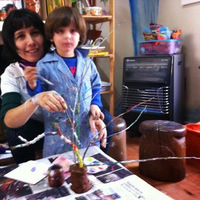









Uploads
Papers by Camila van Diest
Disponible en :
https://hal.science/hal-04672535
https://doi.org/10.18441/ibam.24.2024.86.215-238
Disponible en ligne: https://halshs.archives-ouvertes.fr/halshs-01724626
dans Arts, culture, mémoire, Péquignot, Bruno et Cécile Prévost-Thomas (dir.), Paris, L’Harmattan, coll. Logiques sociales, 2017, pp 89-108.
, which years earlier had been promoted by the chilean government. The meeting, which is realized until today, looked forward to create a platform for the multiplicity of people related to the theater in the region and to democratize the access of the public, facing up the institutional discourse on culture in a city marked by it's status of "cultural capital of Chile". This article proposes different reading keys in order to get an insight of the tensions between both events
Books by Camila van Diest
Disponible en :
https://hal.science/hal-04672535
https://doi.org/10.18441/ibam.24.2024.86.215-238
Disponible en ligne: https://halshs.archives-ouvertes.fr/halshs-01724626
dans Arts, culture, mémoire, Péquignot, Bruno et Cécile Prévost-Thomas (dir.), Paris, L’Harmattan, coll. Logiques sociales, 2017, pp 89-108.
, which years earlier had been promoted by the chilean government. The meeting, which is realized until today, looked forward to create a platform for the multiplicity of people related to the theater in the region and to democratize the access of the public, facing up the institutional discourse on culture in a city marked by it's status of "cultural capital of Chile". This article proposes different reading keys in order to get an insight of the tensions between both events